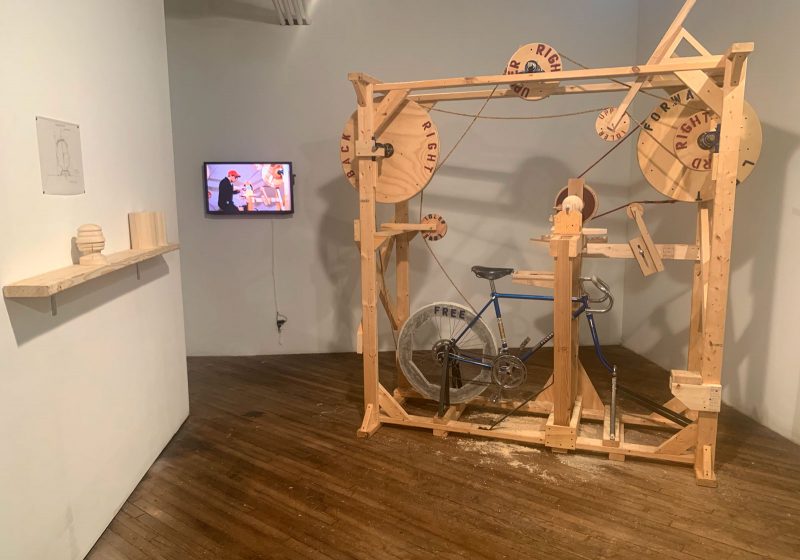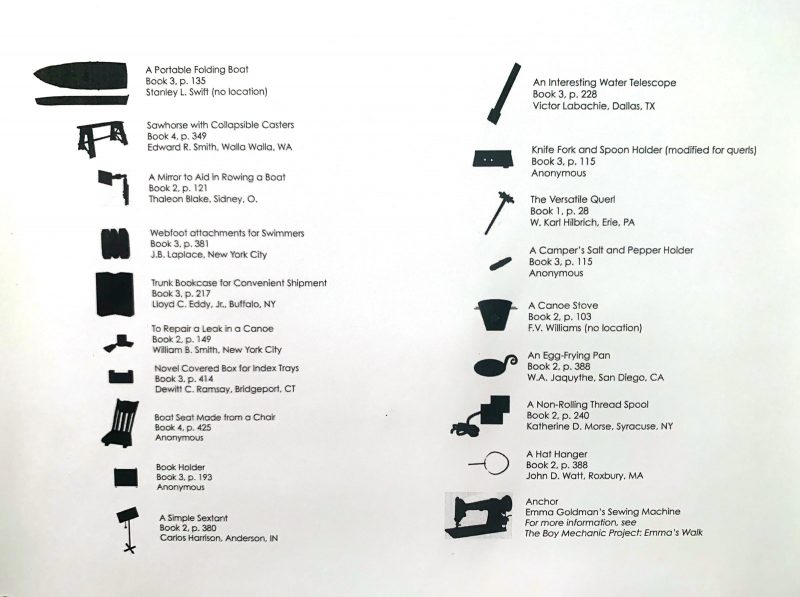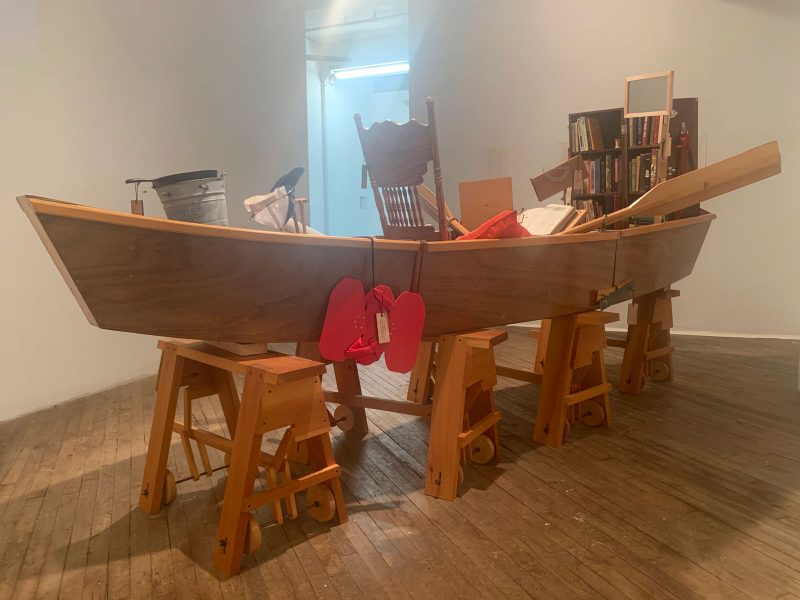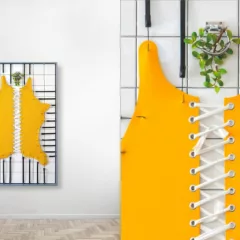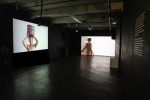Gina Siepel’s show at Vox Populi**, “Self-Made,” is scholarly, intimate, earnest, gently absurd. It tangles with a 19th century idealized version of masculinity and self-making through the source texts of “Popular Mechanics” and popular song, as well as a leap into invention.
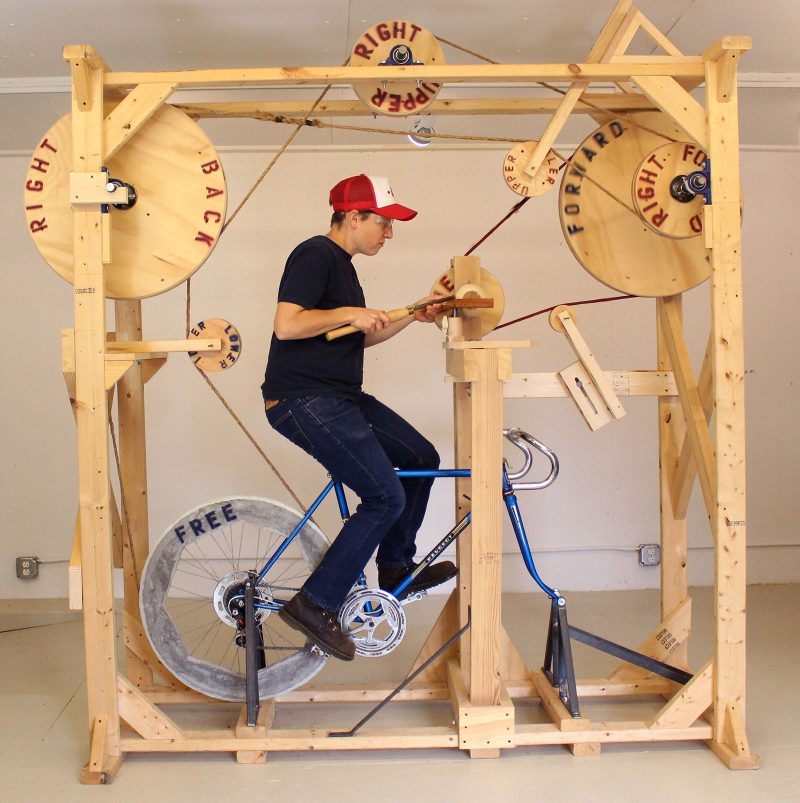
Fragments of the All-American boy
When you enter the gallery, what appears most prominently is a smallish folding, portable rowboat, loaded down with a bookcase, perched atop rolling sawhorses and carrying various handmade woodworking and survivalist projects. It is small for a boat, but large in the space, and intimate in its functional human scale. The un-tinted varnish of the boat reveals its materials and construction. The projects within are sourced from “The Boy Mechanic: 1000 Things for Boys to Do,” a series of books originally published in 1915 by Popular Mechanics, and create a complex microcosm of serious play and exploration. Their placement is considered, and viewers’ continued perusal is rewarded with small moments of revelation and surprise, like the little wood burned tags on various objects adorned with compelling fragments of quotes from “How to Win Friends and Influence People.”
“Cycle for Self-determination,” a Rube Goldberg style pedal-powered lathe stands nearby.
On the wall, a typewritten list of well-known American popular songs from the last 100 years featuring characters named “Johnny” culls fragments that give us clues to Johnny’s identity, and builds a humorous resume based on their lyrics. The results are somewhat surprising and detailed for an archetypal character. Johnny, fairly consistently, loves his Momma.
Two videos, one of an image of the American flag being typed by a typewriter, and another of “Cycle for self-determination” being used, are on view in the space as well.
A queer history of self-reliance
“Self-Made” is an ongoing ten-year project, and many things have shifted in that time, including the national political conversation. “The Boy Mechanic,” with its implied voyage, is in some ways a much more optimistic-seeming piece than the newer Cycle for Self-determination, which is more spartan, unvarnished, and limited in its outcome. Where Boy Mechanic is a voyage of outward expansion through existing schematics, the Cycle is an original invention that enacts a process of inward honing. It’s pedal-powered nature foregrounds labor, exertion and the body, which Siepel will highlight in durational performances with the Cycle on December 7 and 8.
Siepel says that as a gender-nonconforming, masculine presenting queer woman, it was out of a sense of necessity that she became invested in ideals of self-reliance, self-determination, and self-making. Moving to NYC as a young person, Siepel found that she needed to carve out a new identity against the grain of what was expected for her. The history of queer self-reliance is full of the stories of people cut off from economic stability and support networks because of gender presentation and sexuality. Chosen families and DIY skills become necessary for survival outside existing oppressive systems of social support, where a queer or gender-nonconforming person is faced with being medicalized, pathologized, and denied autonomy.
“The Boy Mechanic” books offered a series of solutions to problems of the time: what to do with too many WWI helmets, how to build a tuberculosis cabin, how to electrify a trash can to kill rodents. What emerges out of the project is a quirky and somewhat surprising portrait of the boy at the turn of the century, as strong, ingenious, resourceful, ready to be a maker. Clean and optimistic, he’s globalizing and imperialist as well as a folksy archetype. What does it mean to make oneself as a subject through the making of these projects? What does it mean for Gina Siepel as a queer, gender nonconforming woman to take on the projects detailed in the Boy Mechanic?
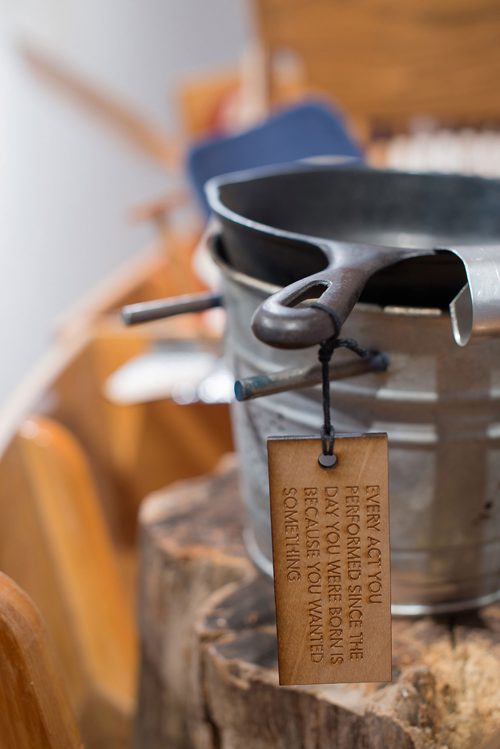
Building a reparative practice
Openness and complexity are important to Siepel, as is critique and that her work be understood as feminist. Because the boat and some other aspects of “The Boy Mechanic” project were not functional as originally detailed in the schematics, Siepel intervened to solve design flaws, to rehabilitate the possibility of their use. Her work can then be read as reparative. By engaging with this text, she reveals the constructed quality of masculinity, and in constructing it herself, reveals its porousness. The process of trying to embody an unattainable narrative of masculinity that cultural norms preclude her from participating in is empowering, as well as absurd.
Siepel’s path to the craft embodied in these pieces began with growing up in rural upstate New York. When her family’s house burned down, she had the experience of helping her family rebuild it from scratch with her brother, although she was very young at the time. It was a community effort that had a lasting impact on her. “It taught us actual skills; it taught us that we could do something big,” she says. Her ever-evolving process is also informed by her time spent working in theater and as a technical director. She often follows a cycle of research, ideation, drawing plans, execution, and installing that can last one to ten years. What she loves is losing herself in a set of terms, a performative sense of having ideas and concepts viscerally inhabit one’s everyday life.
“The Boy Mechanic is a queer coming of age story,” Gina Siepel says, “a classic and universal story.” Of her engagement with Emerson and Thoreau, who feature prominently in the books represented in the boat (alongside books about the Black Panthers and gender self-determination), she says “they were the leftist radicals of their day. We, like them, are the carriers rather than the roots of American Settler Colonial history. Although some things did not age well, their work is fresh and relevant.” The strength of engagement with the past through art is that art “isn’t beholden to the disciplinary rules of journalism, of history. It doesn’t have to have an argument. This means that it can be much more surprising and complicated.”
“Self-Made,” a solo show by Gina Siepel, is on view November 2 – December 16, 2018 at Vox Populi Gallery, 319 North 11th Street, 3rd Floor, Philadelphia PA 19107; Gallery Hours: 12-6, Wednesday – Sunday; Phone: 215-238-1236.
** Author Levi Bentley is a current Vox Populi collective member
More Photos
